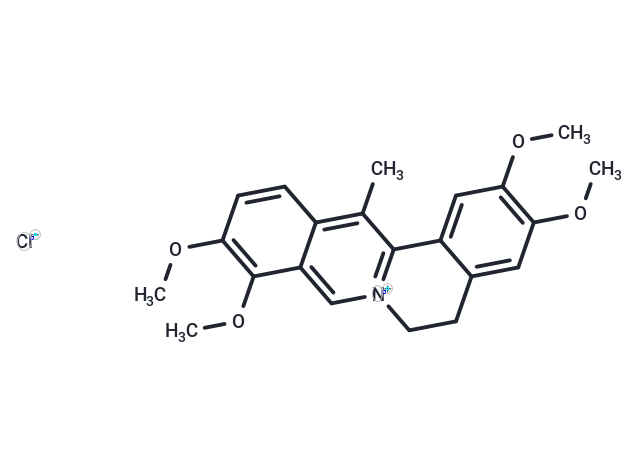Shopping Cart
- Remove All
 Your shopping cart is currently empty
Your shopping cart is currently empty

Dehydrocorydaline chloride (13-Methylpalmatine chloride) is an alkaloid exhibiting anti-inflammatory and anti-cancer activities and can enhance the activation of p38 MAPK.

| Pack Size | Price | Availability | Quantity |
|---|---|---|---|
| 1 mg | $53 | In Stock | |
| 5 mg | $113 | In Stock | |
| 10 mg | $163 | In Stock | |
| 25 mg | $278 | In Stock | |
| 50 mg | $417 | In Stock | |
| 100 mg | $593 | In Stock | |
| 1 mL x 10 mM (in DMSO) | $126 | In Stock |
| Description | Dehydrocorydaline chloride (13-Methylpalmatine chloride) is an alkaloid exhibiting anti-inflammatory and anti-cancer activities and can enhance the activation of p38 MAPK. |
| In vitro | Treatment of C2C12 myoblasts with 500 nM dehydrocorydrine increased the expression of muscle-specific proteins (including MyoD, myogenin, and myosin heavy chain), and enhanced p38 MAPK activation and the interaction between MyoD and E protein. Additionally, dehydrohydroxyproline restored defects in differentiation-induced p38 MAPK activation and differentiation of myoblasts caused by Cdo. Dehydrohydroxyproline significantly inhibited MCF-7 cell proliferation in a dose-dependent manner, reversible by the caspase-8 inhibitor Z-IETD-FMK. It also increased DNA fragmentation without affecting ΔΨm, elevated Bax protein levels, decreased Bcl-2 protein levels, and induced caspase-7 and -8 activation and PARP cleavage, without affecting caspase-9. These findings suggest that dehydrohydroxyproline inhibits MCF-7 cell proliferation by inducing apoptosis through Bax/Bcl-2 regulation, caspase activation, and PARP cleavage. |
| In vivo | Dehydrocobaltate (3.6, 6 or 10 mg/kg, intraperitoneal injection) showed a dose-dependent anti-nociceptive effect in the acetic acid-induced writhing test and significantly reduced formalin-induced mice Pain reaction. In the formalin test, dehydrocorydrine can reduce the expression of caspase 6 (CASP6), TNF-α, IL-1β and IL-6 proteins in the spinal cord. It was confirmed that dehydroyanhusine has an analgesic effect on mice. |
| Alias | 13-Methylpalmatine chloride |
| Molecular Weight | 401.88 |
| Formula | C22H24ClNO4 |
| Cas No. | 10605-03-5 |
| Smiles | [Cl-].COc1ccc2c(C)c3-c4cc(OC)c(OC)cc4CC[n+]3cc2c1OC |
| Relative Density. | 1.23g/cm3 |
| Storage | Powder: -20°C for 3 years | In solvent: -80°C for 1 year | Shipping with blue ice. | ||||||||||||||||||||||||||||||
| Solubility Information | DMSO: 24 mg/mL (59.72 mM), Sonication is recommended. | ||||||||||||||||||||||||||||||
Solution Preparation Table | |||||||||||||||||||||||||||||||
DMSO
| |||||||||||||||||||||||||||||||

Copyright © 2015-2025 TargetMol Chemicals Inc. All Rights Reserved.